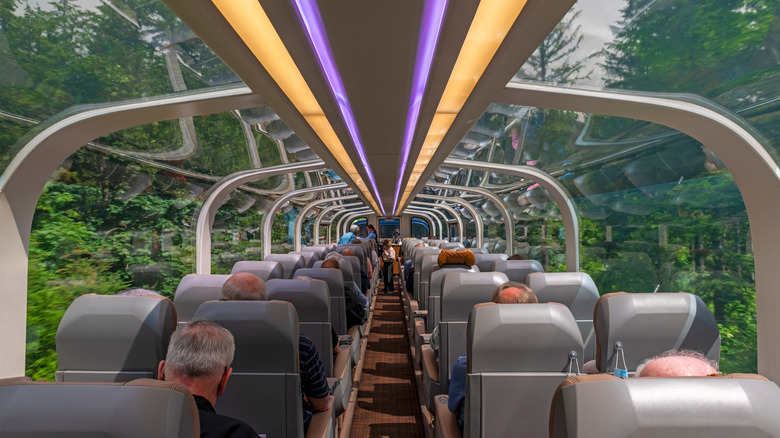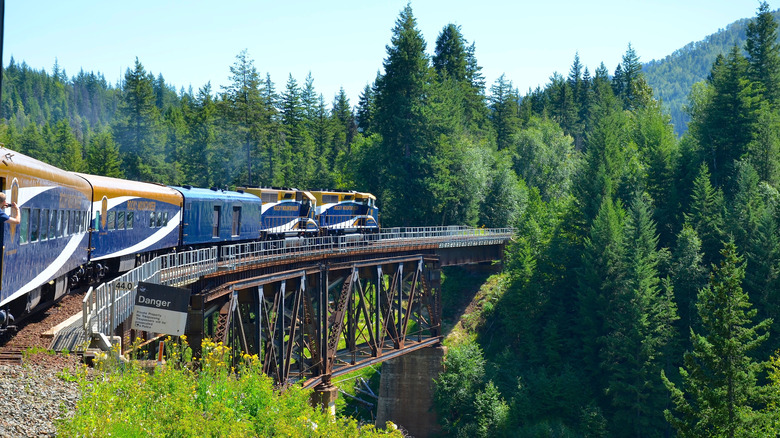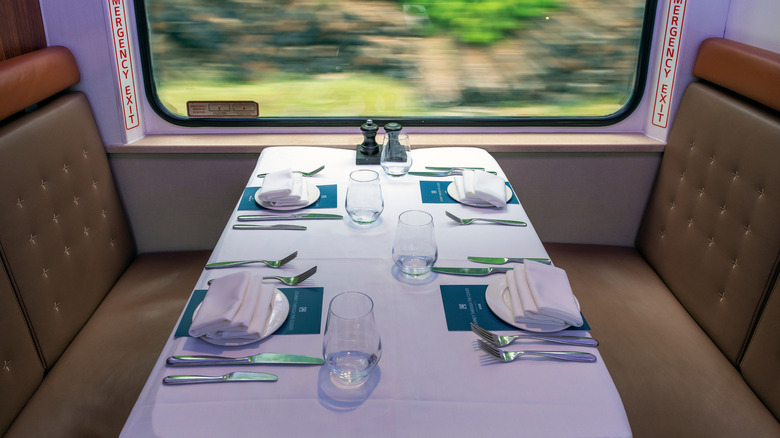Canada's Rocky Mountain Journey On An Award-Winning Train Offers Otherworldly National Park Views
Wow. That's what most people say when they spot the Canadian Rockies for the first time. Those steep cliffs, blankets of forest, and jagged peaks that seem to scrape the sky — what else can you say? This range blends seamlessly with the US' Rocky Mountains, stretching about 1,000 miles across much of Alberta and British Columbia. These mountains aren't just dramatic; they're also tall, with more than 50 summits standing over 11,000 feet above sea level. You could spend weeks admiring this epic terrain, and you'd still see only a fraction of its photogenic vistas.
That's why the "Journey Through the Clouds" train journey came into being. Created by the Rocky Mountaineer railroad company, this 560-mile itinerary starts in Vancouver and cuts through the alpine landscapes of British Columbia, until you arrive in the town of Jasper, Alberta. Passengers can gaze through extra-large windows at the escarpments and evergreens all around, and railroad bridges look out over canyons and roiling rivers.
One of those waterways is the 850-mile-long Fraser River, Canada's largest salmon run; the Fraser River Basin is home to 60 percent of the province's people. Between Vancouver and Jasper, you'll stop at Kamloops, one of the nation's outdoor capitals. This is already a stunning Canadian road trip route for lakes and mountains, but the train takes away the need to drive, so you can focus on the scenery.
The Rocky Mountaineer's long journey
The Rocky Mountaineer was the brainchild of Peter Armstrong, who envisioned turning old railroad lines into modern, luxury train-travel. Armstrong founded the company in 1990, and the Rocky Mountaineer brand has only expanded since; the one-millionth passenger boarded a train in 2008, and the company holds the record for the longest passenger train in Canadian history, at 41 cars.
The Rocky Mountaineer maintains four different routes in Western Canada, along with a fifth route, Rockies to the Red Rocks, that connects Moab, Utah, to Denver, Colorado. Originally from New Brunswick, Armstrong is now famous for his contributions to Canadian tourism, and he serves as Vice Chair for Nature Trust British Columbia.
Journey Through the Clouds takes you through the province's high country, where fog routinely settles in the valleys and mist often crowns the upper mountains. You're also likely to spot wildlife from the window, such as bears and bald eagles. The outdoor thrills continue when the train pulls into its final station in Jasper; Alberta is a budget-friendly destination for adventure seekers. You can actually extend your Rocky Mountaineer trip, thanks to several packages that continue on to Edmonton or Calgary; the two-day train ride still terminates in Jasper, but you'll continue via motor coach over scenic highways; this way, you can sit back, relax, and take as many photos as you want.
Luxury travel aboard the Rocky Mountaineer
The Rocky Mountaineer is no commuter rail; the company caters to tourists who like to travel in style. The seats are comfortable, the dining elevated — incorporating local ingredients and cooking styles — and glass-dome coaches are designed to maximize views. The train only travels during the day, so you won't miss anything in the darkness; this schedule allows you to stay the night in an actual hotel, instead of a cramped sleeper. The Rocky Mountaineer staff pride themselves on hospitality, and you're bound to meet a lot of like-minded travelers over the course of 48 hours.
Granted, you'll have to pay a hefty sum for all this superlative service. The base price for the Journey Through the Clouds tour is $1,705 to $2,976, and that doesn't count arrival in Vancouver and accommodations before and after boarding. But any Rocky Mountaineer route is among the absolute best in the world to travel by train.
Toward the end of your passage, you'll spot Pyramid Creek Falls, a uniquely shaped cascade that tumbles around a stone outcropping. Having passed innumerable mountains, streams, and Arizona-like rock formations, the falls are widely considered the journey's pièce de resistance, a spectacular sendoff before reaching the final platform. Or rather, that's how it is if you travel from Vancouver to Jasper; if you have time, you can always turn around and come back the same way.


